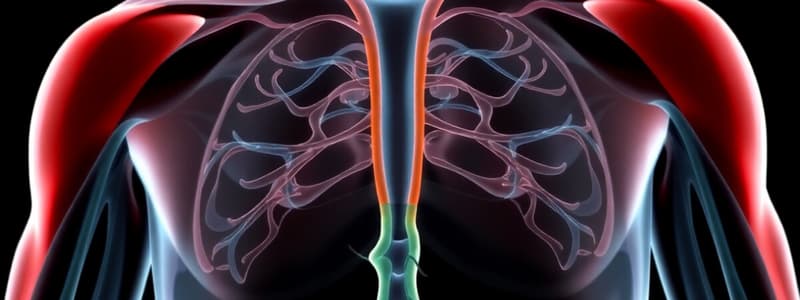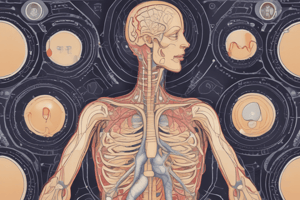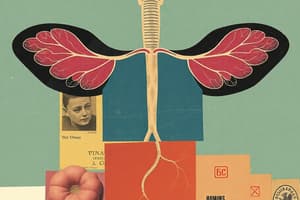Podcast
Questions and Answers
Which physiological process is NOT directly regulated by the endocrine system?
Which physiological process is NOT directly regulated by the endocrine system?
- Maintenance of body posture and balance. (correct)
- Control of digestive processes.
- Homeostasis of blood composition and volume.
- Regulation of development, growth, and metabolism.
What distinguishes endocrine glands from endocrine organs?
What distinguishes endocrine glands from endocrine organs?
- Endocrine glands produce only hormones, whereas endocrine organs perform hormone production in addition to other functions. (correct)
- Endocrine glands secrete hormones directly into ducts, while endocrine organs secrete hormones into the bloodstream.
- Endocrine glands are located throughout the body, while endocrine organs are only found in specific regions.
- Endocrine glands are controlled by the nervous system, while endocrine organs are controlled by hormonal feedback loops.
How do protein-based hormones typically exert their effects on target cells?
How do protein-based hormones typically exert their effects on target cells?
- By activating intracellular second messengers after binding to membrane receptors. (correct)
- By directly influencing the concentration of ions inside the cell.
- By diffusing through the plasma membrane and binding to intracellular receptors.
- By directly altering DNA transcription in the nucleus.
What is the primary role of negative feedback mechanisms in the regulation of hormone release?
What is the primary role of negative feedback mechanisms in the regulation of hormone release?
Which of the following best describes the 'permissiveness' interaction of hormones?
Which of the following best describes the 'permissiveness' interaction of hormones?
If a hormone has a very short half-life, what can be inferred about the nature of that hormone and its effects?
If a hormone has a very short half-life, what can be inferred about the nature of that hormone and its effects?
How does the hypothalamus exert neural control over the endocrine system?
How does the hypothalamus exert neural control over the endocrine system?
Which of the following is an example of synergism between hormones?
Which of the following is an example of synergism between hormones?
How does the adrenal medulla contribute to the body's response to short-term stress?
How does the adrenal medulla contribute to the body's response to short-term stress?
What is the role of the pineal gland, and which hormone does it produce to fulfill that role?
What is the role of the pineal gland, and which hormone does it produce to fulfill that role?
Which hormone is responsible for stimulating the thyroid gland to release thyroid hormone?
Which hormone is responsible for stimulating the thyroid gland to release thyroid hormone?
What is the primary function of antidiuretic hormone (ADH)?
What is the primary function of antidiuretic hormone (ADH)?
Which hormone primarily regulates blood sodium and potassium levels?
Which hormone primarily regulates blood sodium and potassium levels?
Which hormone increases the production of erythrocytes?
Which hormone increases the production of erythrocytes?
What is the function of atrial natriuretic peptide (ANP)?
What is the function of atrial natriuretic peptide (ANP)?
Which hormone stimulates the maturation of T-lymphocytes?
Which hormone stimulates the maturation of T-lymphocytes?
What is the function of cholecystokinin secreted by the small intestine?
What is the function of cholecystokinin secreted by the small intestine?
Which hormone acts on the CNS to produce a feeling of satiety?
Which hormone acts on the CNS to produce a feeling of satiety?
What is the role of gonadotropin-releasing hormone (GnRH) in the endocrine system?
What is the role of gonadotropin-releasing hormone (GnRH) in the endocrine system?
How does the skin contribute to calcium homeostasis?
How does the skin contribute to calcium homeostasis?
What is the effect of insulin on blood glucose levels?
What is the effect of insulin on blood glucose levels?
Which of the following hormones is NOT secreted by the ovaries?
Which of the following hormones is NOT secreted by the ovaries?
What is the role of the placenta in the endocrine system during pregnancy?
What is the role of the placenta in the endocrine system during pregnancy?
What is the chemical classification of sex hormones and adrenal cortex hormones?
What is the chemical classification of sex hormones and adrenal cortex hormones?
How can target cells alter their sensitivity to hormones?
How can target cells alter their sensitivity to hormones?
What are the main factors that concentration of a hormone reflects?
What are the main factors that concentration of a hormone reflects?
Which hormone is responsible for uterine contractions and breast milk release?
Which hormone is responsible for uterine contractions and breast milk release?
What is the role of the hormone Gastrin?
What is the role of the hormone Gastrin?
Which best describes the 'antagonism' interaction of hormones?
Which best describes the 'antagonism' interaction of hormones?
Which best describes lipid-based hormones?
Which best describes lipid-based hormones?
Flashcards
Endocrine System (ES)
Endocrine System (ES)
One of two control systems that regulates metabolic processes in the body using hormones secreted into the bloodstream.
Hormone
Hormone
Chemical substance released by glands/organs that travels in the blood to affect other parts of the body.
Endocrine Glands
Endocrine Glands
Glands with the primary function of hormone production, such as the pituitary and thyroid glands.
Endocrine Organs
Endocrine Organs
Signup and view all the flashcards
Target Cell
Target Cell
Signup and view all the flashcards
Chemistry of Hormones
Chemistry of Hormones
Signup and view all the flashcards
Movement of Hormones into a Cell
Movement of Hormones into a Cell
Signup and view all the flashcards
Target Cell Specificity
Target Cell Specificity
Signup and view all the flashcards
Half-life
Half-life
Signup and view all the flashcards
Permissiveness
Permissiveness
Signup and view all the flashcards
Synergism
Synergism
Signup and view all the flashcards
Antagonism
Antagonism
Signup and view all the flashcards
Negative feedback mechanisms
Negative feedback mechanisms
Signup and view all the flashcards
The Nervous System
The Nervous System
Signup and view all the flashcards
Major Endocrine Glands
Major Endocrine Glands
Signup and view all the flashcards
Endocrine Organs
Endocrine Organs
Signup and view all the flashcards
Pineal and Posterior Pituitary Glands
Pineal and Posterior Pituitary Glands
Signup and view all the flashcards
Anterior Pituitary Gland
Anterior Pituitary Gland
Signup and view all the flashcards
Thyroid and Parathyroid Glands
Thyroid and Parathyroid Glands
Signup and view all the flashcards
Adrenal Glands
Adrenal Glands
Signup and view all the flashcards
Hypothalamus
Hypothalamus
Signup and view all the flashcards
Skin
Skin
Signup and view all the flashcards
Thymus
Thymus
Signup and view all the flashcards
Heart
Heart
Signup and view all the flashcards
Stomach
Stomach
Signup and view all the flashcards
Liver
Liver
Signup and view all the flashcards
Pancreas
Pancreas
Signup and view all the flashcards
Small Intestine
Small Intestine
Signup and view all the flashcards
Kidney
Kidney
Signup and view all the flashcards
Testes
Testes
Signup and view all the flashcards
Ovaries
Ovaries
Signup and view all the flashcards
Placenta
Placenta
Signup and view all the flashcards
Adipose Tissue
Adipose Tissue
Signup and view all the flashcards
Study Notes
- The endocrine system (ES) and the nervous system are the body's two control systems. The nervous system controls the endocrine system.
Ductless System
- The endocrine system lacks vessels for hormone transport, using blood instead.
- It regulates diverse metabolic processes through hormone feedback loops.
- Hormones are released by internal glands/organs directly into the circulatory system, targeting and regulating distant organs.
- The hypothalamus serves as the neural control center for the endocrine system.
Hormone Production
- Hormones are chemical substances produced in one area of the body and transported to another to exert an effect.
- The system comprises glands and organs that synthesize and secrete hormones.
- Endocrine glands lack ducts, releasing hormones into the blood for transport throughout the body.
Hormone Producing Organs
- Endocrine glands produce only hormones including the pituitary, pineal, thyroid, adrenal, and parathyroid glands.
- Endocrine organs produce hormones and fulfill other functions including includes the skin, thymus, heart, liver, stomach, pancreas, small intestine, kidney, gonads, placenta, adipose tissue, and hypothalamus.
Target Cell Specificity
- Some hormones target a few specific cells, while others affect many cell types.
- Target cells have receptors for hormones, located on the cell surface or inside the cell.
- Cells with specific hormone receptors are called target cells.
Homeostasis, Reproduction, Development & Digestion
- The endocrine system regulates blood volume, cellular concentration (WBC, RBC, platelets), and reproductive activities.
- It controls the development of the reproductive system, gamete formation, and sexual characteristics/behaviors.
- The system regulates development, growth, and metabolism, including embryonic cell division, differentiation, and anabolic/catabolic processes.
- Hormones influence secretory processes, movement of materials, and chemistry within the digestive tract.
Hormone Chemistry
- Hormones are classified as either proteins or steroids.
- Sex hormones (gonadal) and adrenal cortex hormones are steroid hormones.
- All other hormones are proteins or protein derivatives.
Hormone Action
- Hormones affect membrane permeability, stimulate protein synthesis, activate/deactivate enzymes, influence secretions, and impact mitosis.
Movement of Hormones
- Protein-based hormones exert effects through intracellular second messengers activated upon binding to membrane receptors.
- Lipid-based hormones diffuse into cells, bind to intracellular receptors, and migrate to the nucleus due to structural similarity with the plasma membrane.
- Examples of second messengers include cyclic AMP, cyclic GMP, inositol triphosphate, diacylglycerol, and calcium.
Target Cell Response
- Target cell specificity is due to intracellular receptors.
- Target cell response depends on hormone levels, number of receptors, and receptor affinity.
- Target cells can change sensitivity by altering receptor numbers.
Hormone Concentration
- Hormone concentration reflects release rate, inactivation rate, and removal rate.
- Half-life is the time needed to reduce hormone concentration by 50%.
- Water-soluble hormones like insulin and glucagon have the shortest half-lives and transient effects.
Interactions of Hormones
- Permissiveness: a hormone exerts full effects in the presence of another (e.g., thyroid hormone enhances epinephrine, cortisol enhances growth hormone).
- Synergism: multiple hormones produce the same effect, amplifying the combined effect (e.g., testosterone and growth hormone for size, epinephrine and norepinephrine for heart rate, estrogen, prolactin, oxytocin and cortisol for lactation).
- Antagonism: one hormone opposes another (e.g., insulin and glucagon regulate blood sugar, parathyroid hormone and calcitonin regulate blood calcium).
Regulation of Hormone Release
- Negative feedback mechanisms have the most control over hormone release, where the product inhibits its own production.
- Hormonal control: Gonadotropin-releasing hormone (GnRH) determines the secretion pattern of follicle-stimulating hormone (FSH) and luteinizing hormone (LH), regulating endocrine function and gamete maturation.
- Nervous system: Directly stimulates endocrine glands to release hormones via neural stimuli (e.g., epinephrine and norepinephrine for short-term stress response).
Major Endocrine Glands
- Major endocrine glands that secrete only hormones include the pituitary, pineal, thyroid, adrenal, and parathyroid glands.
- Endocrine organs secrete hormones and perform other functions, including the skin, thymus, heart, liver, stomach, pancreas, small intestine, kidney, gonads, placenta, adipose tissue, and hypothalamus.
Pineal and Posterior Pituitary Glands
- Pineal gland: Regulates the body’s circadian rhythm using melatonin.
- Posterior pituitary gland: Stores and releases oxytocin and antidiuretic hormone produced in the hypothalamus.
- Oxytocin (OT): causes Uterine contractions, and breast milk release.
- Antidiuretic hormone (ADH): regulates Fluid balance.
Anterior Pituitary Gland
- Thyroid-stimulating hormone (TSH): stimulates the thyroid gland to release thyroid hormone.
- Prolactin (PRL): is used for breast milk production.
- Follicle-stimulating hormone (FSH): affects the development of gametes and follicles in females.
- Luteinizing hormone (LH): impacts the development of gametes and ovulation in females.
- Adrenocorticotrophic hormone (ACTH): stimulates the adrenal cortex to release corticosteroids (= steroid hormones).
- Growth hormone (GH): stimulates cell growth and division.
Thyroid and Parathyroid Glands
- Thyroid gland: impacts metabolism using the thyroid hormone (TH) and blood calcium levels by using calcitonin which decreases blood calcium levels.
- Parathyroid glands: regulates blood calcium levels using the parathyroid hormone (PTH) which increases blood calcium levels.
Adrenal Glands
Adrenal medulla
- Uses catecholamines (epinephrine and norepinephrine) to prolong the fight-or-flight response. Adrenal cortex
- Mineralocorticoids e.g aldosterone: regulates blood sodium and potassium levels.
- Glucocorticoids e.g cortisol: participates in stress response.
- Gonadocorticoids e.g androgens: stimulates the maturation and functioning of the reproductive system.
Organs containing endocrine cells
- Hypothalamus: Oxytocin and antidiuretic hormones are produced in the hypothalamus and stored and released from the posterior pituitary, with Oxytocin (OT) causing uterine contractions, and breast milk release and the Antidiuretic hormone (ADH) regulating the fluid balance.
- Skin: Produces Cholecalciferol, which is an inactive form of vitamin D3, which is later converted to calcitriol through enzymes in the liver and kidney and promotes absorption of calcium from the gastrointestinal(GI) tract into the blood
- Thymus: Produces Thymosin, thymulin, and thymopoietin and stimulates maturation of T-lymphocytes and the development of the immune response.
- Heart: Produces Atrial natriuretic peptide (ANP) which regulates blood sodium levels, blood volume, and blood sodium concentration.
- Stomach: Produces Gastrin, which is a peptide hormone that increases secretions and motility of the stomach, and pepsin which is the mature active form of pepsinogen, which is used for protein digestion and stimulates secretion of gastric acid (HCl).
- Liver: Produces Angiotensinogen, which regulates blood volume and blood pressure, and Erythropoietin (EPO) which increases the production of erythrocytes.
- Pancreas: Produces Insulin, which decreases blood glucose, and Glucagon, which increases blood glucose.
- Small Intestine: Secretes Secretin and Cholecystokinin which regulate digestive processes of the small intestine.
- Kidney: Secretes Erythropoietin (EPO) which Increases the production of erythrocytes.
- Gonads: Testes and Ovaries; Testes secrete androgens (testosterone) and inhibin, which stimulates maturation and function of the male reproductive system.
- Gonads: Testes and Ovaries; Ovaries produce Estrogen, progesterone and inhibin, which stimulate maturation and function of the female reproductive system.
- Placenta: Secretes Estrogens, Progesterone and Human chorionic gonadotropin(hCg), which act on the uterus to influence pregnancy.
- Adipose Tissue: Secretes Leptin which acts on the CNS to produce a feeling of satiety, and Resistin which is an insulin antagonist.
Studying That Suits You
Use AI to generate personalized quizzes and flashcards to suit your learning preferences.




